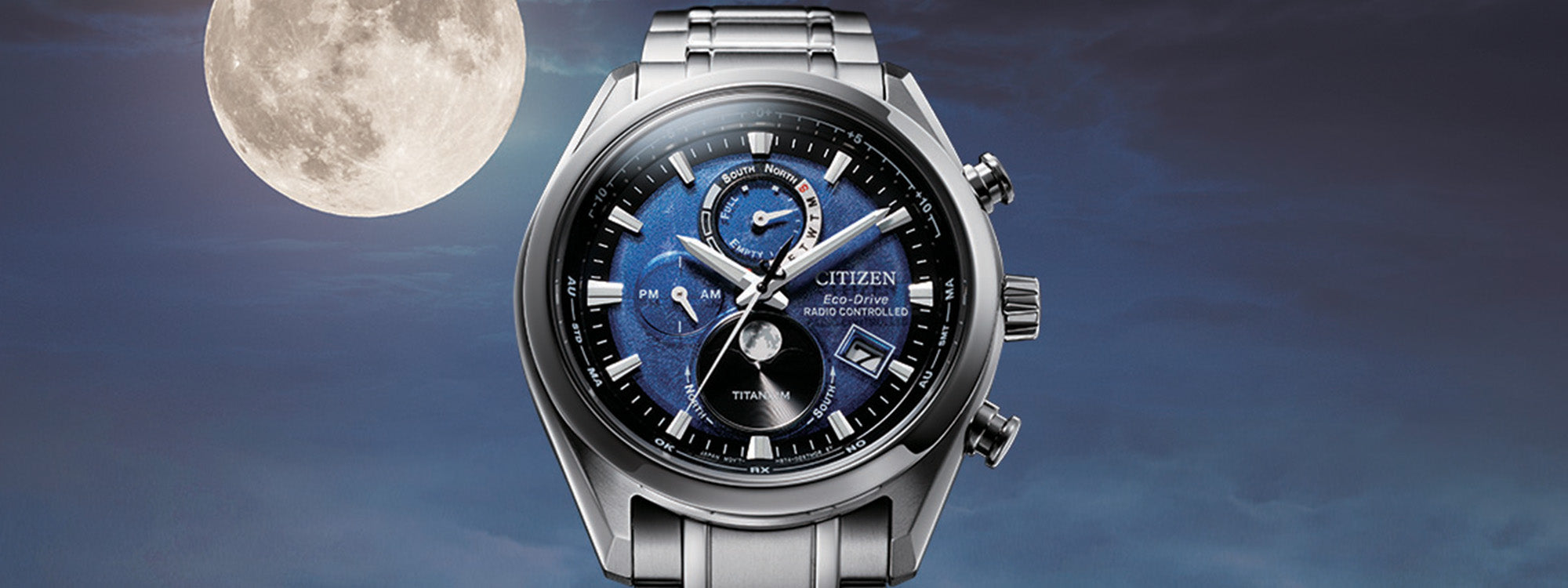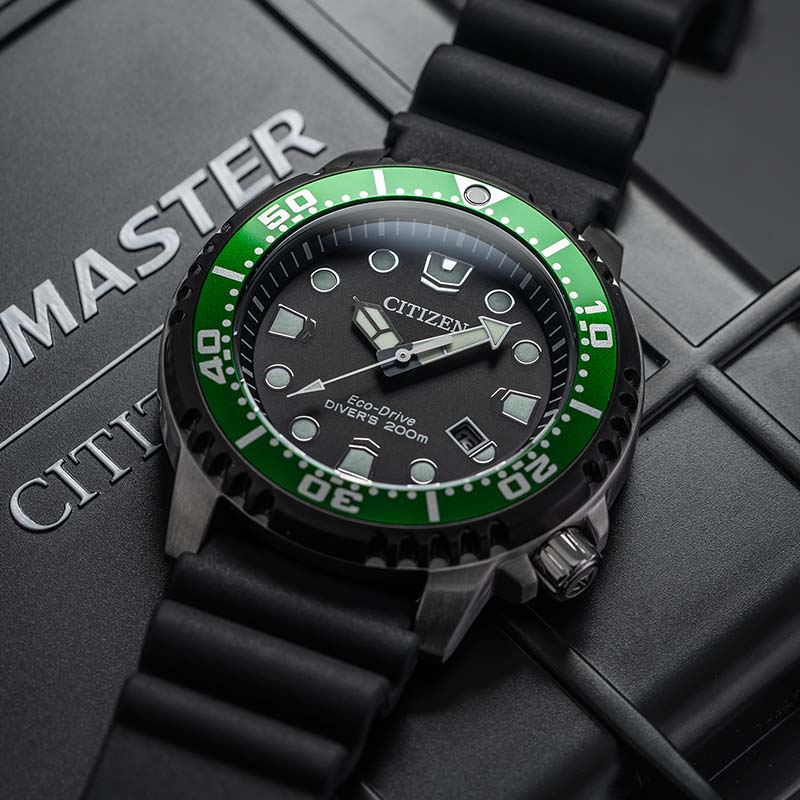Japan’s Citizen Watch Company marks 100 years of watchmaking in 2024, and some of its most noteworthy recent timepieces provide ample proof that, despite being in business for a full century, the brand’s drive toward forward-thinking technology and avant-garde design has not yet started to slow down. Take for example the Citizen Tsuki-yomi A-T, unveiled in Fall of 2023 — which is the culmination of 30 years of Citizen’s pioneering work in the field of radio-controlled atomic timekeeping. It is the first light-powered watch with a fully analog moon-phase display, and the first moon-phase that requires no manual adjustments whatsoever from the wearer thanks to its high-tech movement, Eco-Drive Caliber H874, which receives signals from six multi-band radio transmitters.

The name “Tsuki-yomi” is derived from a Japanese phrase meaning “reading the moon,” and also refers to a moon god from ancient Japanese mythology, while the “A-T” is an abbreviation for “Atomic Timekeeping.” For the ingenious Eco-Drive movement, which runs to an astounding accuracy of +/- 15 seconds per month, Citizen’s designers developed a special mathematical formula that calculates the exact position of the moon on each day of the year by using the radio transmission signals from the world’s atomic clocks. The watch’s dial is also a distinguishing feature: its surface is enhanced with a textural lunar landscape motif of craters, moondust and lakes that is “bold yet subtle enough for daily wear” (Citizen’s worlds, but I cannot help but concur). The moon disk appears in an aperture at 6 o’clock, along with an AM/PM indicator at 9 o’clock,a slightly slanted date window at 4:00; and a multifunction subdial at 12 o’clock that incorporates an analog day pointer, a power-supply indicator for the watch’s light-powered charge, and one of the watch’s unique features, a “North-South” indicator that can be toggled (via an extraction of the crown) to show the current moon-phase in either hemisphere. The fact that the watch is also a perpetual calendar — meaning that no manual adjustments to the date will ever be necessary, at least within the lifespan of its first owner — almost seems a quaint afterthought, though no less impressive.

Truly appreciating the technical and aesthetic milestone that Citizen has achieved with the Tsuki-yomi A-T — and full disclosure, this is a watch that I own and find myself wearing way more often than I thought, and certainly more often than some pricier mechanical timepieces in the lineup — almost demands a breakdown of all the innovations in it and where they came from. Of course, one of these is Eco-Drive, the light-powered movement technology that Citizen pioneered and which has since become central to its brand identity. And rather than try to drill down once again on the origins and technical details of this game-changing invention, I will direct anyone unfamiliar with Eco-Drive to my comprehensive feature on it here. As with all Eco-Drive watches, the Tsuki-yomi A-T can draw constant energy from the rays of the sun or any other light source; what makes this model special is the painstaking work that had to be done to create a sapphire dial that was translucent enough to admit light to the solar cell while still being able to host the eye-catching, moonscape color patterns that set this watch apart. Citizen offers three of them in the first round of Tsuki-yomi references — gray (Ref. BY1010-57H); red (BY1018-55X); and my own much-admired blue (Ref. BY1010-57L)

Another crucial element of the watch, which contributes both to its sleek appearance as well as its enviable wearability and lightness on the wrist, is the Super Titanium used for its 43mm case and supple three-link bracelet. In 1970, Citizen became, somewhat quietly, the first watchmaker to release a watch with a case made entirely of titanium, a strong, lightweight, corrosion-resistant material that had gained a higher profile in the manufacturing world at the time thanks to its use in the aerospace industry. In 1982, Citizen used titanium for the case of its first Professional Diver watch, a forerunner of the modern Promaster collection, and in 1987 launched Attesa, its first all-titanium collection. The brand’s most important materials technology came in 2000, when it started using a proprietary treatment called Duratect on its titanium cases, which hardened the metal’s already-tough surface by a factor of five over stainless steel and opened up the possibilities of other finishes and colorways beyond titanium’s usual matte-gloss appearance. This “Super Titanium” has been a mainstay in Citizen’s collection ever since; in the Tsuki-yomi A-T, its surface versatility is evident in the array of polished and brushed areas, most prominently in the articulating bracelet.

Citizen Multizone 7400 from 1993 (photo: WatchCharts Marketplace)
Perhaps most impressive in its evolution from its original iteration is the multi-band radio-controlled time regulation, driven by the world’s six atomic clocks, which gives this watch its “A-T” designation and plays the key role in the user-friendly, autonomous moon-phase function. Citizen introduced the first radio-controlled wristwatch, the Multizone 7400, in 1993. It was then, and remains today, one of the most unusual timepieces the Japanese brand has ever produced and a prime example of its technical and design boldness. Back in 1993, the technology was still in relative infancy, and the antenna required to receive the radio-controlled time signals needed to be large and prominent on the dial — hence the quirky design of the 1993 model, which places a clear tube with the receiver coil smack dab in the middle of the dial, effectively bisecting it into halves, with an analog date on the left and a 24-hour time display on the right. It took 10 more years for Citizen to improve upon the design, and to merge the multi-band time receiver with the signature Eco-Drive system, in a more streamlined timepiece; it launched the Eco-Drive Radio Controlled model in a full-metal case in 2003. This model’s antenna was much smaller and more subdued, tucked out of sight behind the light-absorbing dial. Another decade passed before Citizen took the next step (after testing the waters with a concept watch in 2011) with 2013’s Satellite Wave-Air GPS watch, the first wristwatch able to receive signals from GPS satellites to automatically adjust the time. For the 30th anniversary of the technology — are you starting to sense a pattern here? — Citizen has poured all of these elements into the technical marvel that is the Tsuki-yomi, which also happens to be an eminently wearable and very stylish timepiece for the wrist.

Citizen Satellite Wave Concept Watch (2011)
Tracing a straight line from the 1993 model to this one, one can’t help but be impressed by what Citizen has accomplished in the ensuing three decades in the area of radio-controlled atomic timekeeping. The Tsuki-yomi A-T is in every respect an elegant, style-oriented timepiece, offering comfort and lightness on the wrist, user-friendly functions, an analog dial with a stunning visual motif rarely found in this sub-$1,000 price tier, and what many, though not all, would consider reasonable dimensions. At 43mm diameter and 10.9mm thick, the Tsuki-Yomi would certainly dominate a thinner wrist that is more accustomed to watches 40mm or even smaller, but here’s where I’d make the case that the lightness of the Super Titanium case and bracelet, the legibility of the functions, and the sheer beauty of the lunar-motif dial more than justify the overall expanse. At some point, smaller versions of the Tsuki-yomi would seem to be an inevitability; let's hope Citizen doesn't wait for the next decade anniversary to cater to this segment of the audience.




























































2 Comments
Normally I will not consider Citizen, but this Tsukiyomi AT caught my eye. It is very appealing.
The question is how long does the battery last? Is it protected from magnetic interference? And how much does it cost?
Agreed it’s very beautiful and i got one my self in the grey-white variant (which also realistically represents the moon). The watch is solar and does not have a battery but a capacitor. It can last up to 2.5 years in power reserve mode or up to 6 months in normal mode. The watch costs retail ~800 euros but you can find deals down to ~650 euros if you know a good dealer that is willing to lower his profit margin. Finally yes the watch is protected from magnetic interference!
I have to add that it really weighs almost nothing on the wrist (due to the titanium build), DOES NOT feel/wear like 43 but rather like 40-41. Overall it is a fantastic watch that you can where anywhere, any day!